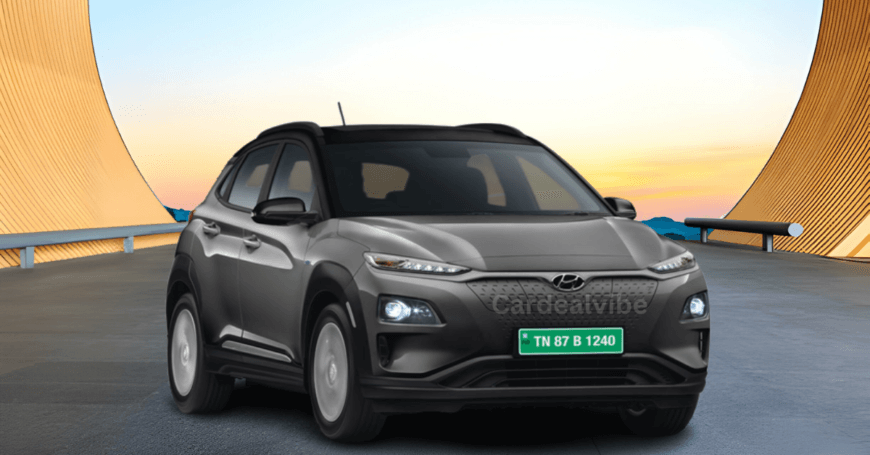BMW i4 Car
The electric BMW i4 has five seats. BMW i4 pricing begins at ₹ 72.50 Lakh and reaches ₹ 77.50 Lakh for the top variant. With a battery range of 483 to 590 km, it comes in two configurations. It has eight safety airbags in this variant. With a top speed of 190 kmph, it can cover a distance of 0 to 100 km in just 5.7 seconds. There are four color options for this model. The overall user rating of the BMW i4 EV is 4.1 out of 5 based on feedback from other users.
| Pros | Cons |
| Quiet cabin | support for the rear thighs |
| Outstanding performance and dynamics | pricey to purchase |
| decent scope |
Read More On: Hyundai Kona Electric
Hyundai Kona Electric
Hyundai Kona Electric is an electric vehicle with five seats. The base price of the Hyundai Kona Electric is ₹ 23.84 Lakh, while the top variant is ₹ 24.03 Lakh. It comes in two versions, each with a 452 km battery life. It features quick charging capabilities and can be charged in 19 hours using AC power (2.8 kW, 0%–100%). This model includes six airbags for protection. There are 5 colors available for this model. Hyundai Kona Electric EV has received an overall user rating of 4.4 out of 5 based on reviews from other users.
| Pros | Cons |
|
|
|
|
|
|
|
|
| |
|
Read More On: Mahindra XUV700
Latest Cars Under Rs 10 – 21 Lakhs In India
Hyundai Creta pricing ranges from ₹ 11 Lakh to ₹ 20.15 Lakh for the top variant. It has 28 different models with 1482 and 1497 cc engine options. Both manual and automatic transmissions are available for this vehicle, and it can run on gasoline or diesel.
Color Options: Robust Emerald Pearl, Fiery Red, Ranger Khaki, Abyss Black, Atlas White, Titan Grey, and Atlas White with Black Roof are the six monotone and one dual-tone color options offered for the Creta.
Engine and Transmission: There are three available engine options for the Hyundai Creta. 1.5-liter gasoline with natural aspiration (115 PS/144 Nm): 6-speed CVT and MT 1.5-liter turbo-petrol (160 horsepower and 253 nm): DCT with seven speeds Diesel 1.5-liter (116 PS/250 Nm) with 6 speeds (MT, AT). Stated Fuel Economy: 1.5-liter gasoline vehicle: 17.4 km/l 1.5 liters of gasoline 17.7 km/l CVT 18.4 km/l with a 1.5-liter turbo-petrol DCT 1.5-liter gasoline MT: 21.8 m3/l Diesel 1.5-liter AT: 19.1 km/l
Features: The updated Creta has linked car technology and two 10.25-inch displays, one for the infotainment system and the other for the instruments. In addition, it has a panoramic sunroof, wireless phone charging, an 8-speaker Bose sound system, dual-zone air conditioning, an 8-way power-adjustable driver’s seat, and ventilated front seats.
Six airbags, an electronic stability control system, a 360-degree camera, a tire pressure monitoring system, and a few advanced driver assistance systems (ADAS) are among the safety features.
Rivals: The Hyundai Creta faces off against the Volkswagen Taigun, Citroen C3 Aircross, Honda Elevate, Kia Seltos, Maruti Grand Vitara, Toyota Hyryder, and Skoda Kushaq.
Read More: New Launched Car Under Rs 1 – 5 Crores
New Launched Car Under Rs 1 – 5 crores
The Lexus LM is an MUV hybrid. The base price of a Lexus LM is ₹ 2 Cr, while the top variant can cost up to ₹ 2.50 Cr. There is a 2487 cc engine option for this model. This vehicle is offered with an automatic transmission and a gasoline alternative. There is only one color option for this model. Lexus LM has received an overall user rating of 4.4 out of 5 based on reviews from other users.
The Lexus LM 350h is a hybrid model. Consequently, a 2.5-liter inline-4 engine producing 190 horsepower and 242 Nm coupled with two electric motors powers this opulent MPV. The front axle has a 180 horsepower motor, and the rear axle has a 54 horsepower motor.
Features: The MPV is equipped with a 48-inch wide rear display (when the four-seater version is chosen), 64-color ambient lighting, heated and ventilated rear seats with a warmth infrared sensor, and dual-zone climate control. In addition, it has a 14-inch infotainment system, two huge screens for the digital driver’s display, and a 10-inch heads-up display.
Safety features include hill assist, multiple airbags, vehicle stability control (VSC), and a plethora of advanced driver assistance systems (ADAS) like high-beam assist, lane departure warning, and front collision warning.
Read More On: New Launched Car In 2024 Under Rs 5 – 10 Lakhs







